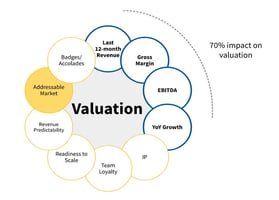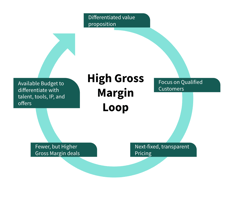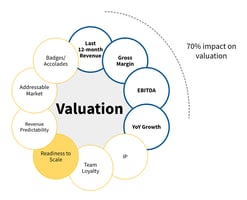Emerging Technology Services startups are specialist organizations. They focus on a particular...
AI x ABM: The Future of Sales and Marketing

In 2025, the line between sales and marketing has blurred. Once seen as separate entities, they must now operate as a unified force, especially for Emerging Technology Services (ETS) firms. While that alignment deserves its own deep dive, today we’re focusing on how sales and marketing teams execute Account-Based Marketing (ABM) strategies with AI-powered tactics.
For ETS firms, traditional sales and marketing demanded countless hours of building content, running outreach campaigns, and nurturing leads across a wide funnel. Time and resources are often limited, making this model inefficient.
But AI has completely changed the game. It doesn’t just accelerate ABM, but it redefines what’s possible.
What once took hours of manual research and customization can now happen in seconds. From personalized content generation to smarter distribution and full-cycle automation, AI empowers small teams to operate like enterprise giants.
Ways AI Has Transformed ABM
1. Content Personalization at Scale
One of the key components of ABM is content personalization to the target accounts. This has traditionally been extremely human-intensive. Usually, this involved creating more materials, rewriting existing materials with different goals and outlooks, organizing and managing the materials, and creating a hierarchy based on the customer’s anticipated needs.
AI has changed the script on this.
- Creating new material: This has become significantly easier. Now, you can hook up an AI bot to your systems of records, including email, instant messaging apps, project management tools, deliverables, etc., to give the AI an understanding of the full project and customer needs. You can use this information to draft relevant case studies quickly.
Example prompts:
“Create a case study based on project details and customer conversations that show how we solved the customer problem.”
“Suggest 5 blog posts based on the customer’s project details and outcomes.”
“Draft a blog post detailing the challenges in implementing <solution>.”
- Rewriting existing content: This is even easier. You can feed the content into the AI. Give any supplemental information you want to add. And prompt the AI to rewrite the content according to your new needs. Some example instructions you could use:
“Can you modify this article to showcase the work in compliance?”
“Can you showcase how this case study was used in the manufacturing space and how the problems faced were critical to manufacturing?”
- Organizing content: It has traditionally been a great challenge. The more content you create, the more important it is to manage it well so you can use the right content at the right time. However, with AI, the equation has completely changed. Instead of managing treasure troves of content, you already have the AI programmed with the existing data and all your content. You can give it an understanding of the situation with prompts like:
“I would like to send a cold outreach to the <targeted account> of <targeted company> for our <solution name> solution. What material/tactics do you suggest I use?"
“What existing content would you suggest I share with <targeted account> to get an engagement from them?”
“Can you create custom content relevant to <targeted account>?”
“Generate relevant case studies relevant to <targeted account>.”
2. Smarter Distribution
One of the most overlooked aspects of ABM is when, where, and how content is distributed. You can have the most personalized asset, but it falls flat if it reaches the wrong stakeholder or hits their inbox at a poor time. Traditionally, distribution has relied heavily on scheduling tools, gut instinct, or broad assumptions based on buyer personas.
AI tackles these areas:
- Intent data: This is when AI gathers information on what your target accounts are researching on third-party sites.
“Which of our targeted accounts will engage with us with our <solution name> based on their interests?”
“Show me the top-performing content our target accounts are searching for online.”
“Out of our current blogs and SEO, which ones will our targeted accounts engage with the most”?
“Assess the current high-impact whitepapers, case-studies, and E-books, which ones would our targeted accounts likely engage with?”
- Behavioral signals: AI analyzes how many targeted accounts visit your pricing page or watch a demo available on your website and finally assesses how many engage with a webinar, blog, roundtable, or on-site event through registration counts.
“Which target accounts have been engaging with our case studies recently?”
“How many targeted accounts have registered this year for our <title> webinar compared to last year's <title> webinar?”
“Categorize how many targeted accounts are engaging with what tier of pricing model for our <solution>.”
“Which content touchpoints contributed most to high-scoring accounts in the last quarter?”
- Predictive scoring: Targeted accounts will leave some traces of interest behind, and AI captures this, converting it into data that shows how likely a specific account is to convert based on recent digital footprints.
“Rank these 25 accounts by intent and engagement level to prioritize outbound.”
“Based on behavioral data, which 5 accounts should we prioritize this week for outreach?”
“Assign a conversion score (1-10) to each account using data from <your company>'s CRM, website analytics, and email interactions.”
3. Process Automation
ABM requires a lot of effort and resources to create customized outreach, track engagement, and qualify leads. Traditionally, this meant manually building workflows, monitoring CRMs, scheduling meetings, and flagging warm leads using big teams. But AI-driven process automation has single-handedly redefined that workflow, and here's how:
- Outreach: This process becomes dynamic. Personalized messages can be automatically adjusted based on opens, clicks, and actions taken.
“Pause paid ads for accounts that haven’t opened the last two nurture emails.”
“Automatically move a lead to sales-qualified status if they watch a full product webinar and download a whitepaper.”
- Meeting scheduling: Now, promptly scheduling meetings and following up engagement is streamlined through AI assistants, which can book time with key stakeholders without back-and-forth emails.
“Book a follow-up demo with any target account that visits the ‘Security’ landing page twice in 48 hours.”
“Auto-schedule a call with any user who visits our demo page and fits our top priority ICP.”
- Lead scoring: The scoring process becomes more data-driven, eliminating guessing and missed chances. This is done by assessing targeted accounts based on firmographics, behavioral data, and intent signals.
“Score this list of leads using company size, industry fit, and whether they’ve interacted with our compliance content.”
“Generate a ranked list of accounts with the highest lead scores based on website visits and email opens.”
“Based on historical data and webinar attendance, which leads are closest to sales-ready?”
- Engagement alerts: Notifications can reach your teams in real-time when a targeted account interacts with a high-value piece of content or revisits your pricing page. This gives the sales and marketing team the right time to engage with the targeted accounts.
“Trigger an alert when someone views our ‘Case Studies’ page and spends more than 2 minutes.”
"Two executives from <targeted account> signed up for your newsletter within the same week."
.png?width=1920&height=1080&name=ABM%20(1).png)
Wrapping Up
By integrating AI into ABM, ETS firms can reclaim time, sharpen focus, and close deals faster. What once required multiple full-time roles can now be streamlined using smarter AI tools.
At Vixul, our agentic AI, Vixie, powers our ABM strategy by identifying customer pain points and shaping more meaningful engagement. With Vixie’s insights, we’ve crafted tailored case studies that speak directly to what our accounts care about. And we’re not the only ones, our portfolio companies also use Vixie to get insights and so much more.
If you're ready to reform your ABM strategy with Vixie, apply to join the next cohort here:
Vixul's Accelerator Cohort Application
Read more of our ABM articles here:





